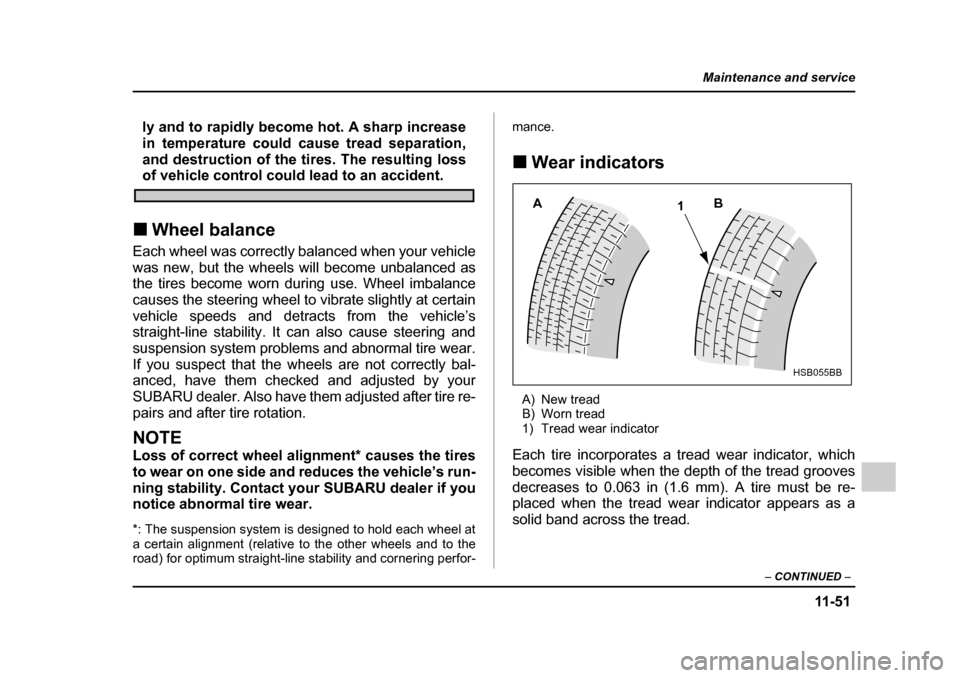Page 309 of 507

8-2
Driving tips
Driving tipsNew vehicle break-in driving – the
first 1,000 miles (1,600 km)
The performance and long life of your vehicle are de-
pendent on how you handle and care for your vehicle
while it is new. Follow these instructions during the
first 1,000 miles (1,600 km):�y
Do not race the engine. And do not allow engine
speed to exceed 4,000 rpm except in an emergency.�y Do not drive at one constant engine or vehicle
speed for a long time, either fast or slow. �y Avoid starting suddenly and rapid acceleration, ex-
cept in an emergency. �y Avoid hard braking, except in an emergency.
The same break-in procedures should be applied to
an overhauled engine, newly mounted engine or when
brake pads or brake linings are replaced with new
ones.
Fuel economy hints
The following suggestions will help to save your fuel. �y Select the proper gear position for the speed and
road conditions. �y Avoid sudden acceleration or deceleration. Always
accelerate gently until you reach the desired speed.
Then try to maintain that speed for as long as possible. �y Do not pump the accelerator and avoid racing the
engine. �y Avoid unnecessary engine idling.
�y Keep the engine properly tuned.
�y Keep the tires inflated to the correct pressure shown
on the tire placard, which is located under the door
latch on the driver’s side. Low pressure will increase
tire wear and fuel consumption.�y Use the air conditioner only when necessary.
�y Keep the front and rear wheels in proper alignment.
�y Avoid carrying unnecessary luggage or cargo.
Page 432 of 507

11 -5 1
Maintenance and service
– CONTINUED –
ly and to rapidly become hot. A sharp increase
in temperature could cause tread separation,
and destruction of the tires. The resulting loss
of vehicle control could lead to an accident.
�„ Wheel balance
Each wheel was correctly balanced when your vehicle
was new, but the wheels will become unbalanced as
the tires become worn during use. Wheel imbalance
causes the steering wheel to vibrate slightly at certain
vehicle speeds and detracts from the vehicle’s
straight-line stability. It can also cause steering and
suspension system problems and abnormal tire wear.
If you suspect that the wheels are not correctly bal-
anced, have them checked and adjusted by your
SUBARU dealer. Also have them adjusted after tire re-
pairs and after tire rotation.
NOTE
Loss of correct wheel alignment* causes the tires
to wear on one side and reduces the vehicle’s run-
ning stability. Contact your SUBARU dealer if you
notice abnormal tire wear.
*: The suspension system is designed to hold each wheel at
a certain alignment (relative to the other wheels and to the
road) for optimum straight-line stability and cornering perfor- mance. �„
Wear indicators
A) New tread
B) Worn tread
1) Tread wear indicator
Each tire incorporates a tread wear indicator, which
becomes visible when the depth of the tread grooves
decreases to 0.063 in (1.6 mm). A tire must be re-
placed when the tread wear indicator appears as a
solid band across the tread.
A 1B
HSB055BB
Page 466 of 507
12-1
12
Specifications
Specifications ................................................ 12-2 Dimensions ....................................................... 12-2
Engine ................................................................ 12-3
Electrical system .............................................. 12-3
Capacities .......................................................... 12-4
Tires ................................................................... 12-5
Wheel alignment ............................................... 12-6
Fuses and circuits ........................................ 12-7 Fuse panel located behind the coin tray ....... 12-7
Fuse panel located in the engine compartment .................................................. 12-9
Bulb chart ...................................................... 12-10
Vehicle identification .................................... 12-11
Page 471 of 507
12-6
Specifications �„
Wheel alignment
ItemSedanWagon
2.5-liter
non-turbo2.0-liter turbo2.5-liter turbo2.5-liter non-turbo2.0-liter turbo
RS, RS sport packageWRXWRX-STiRSOUTBACK SPORTWRX
Drive systemAWD
ToeFront0 in (0 mm)
Rear0 in (0 mm)
CamberFront–0 °15’–0 °25’–0 °30’–0 °10’–0 °05’–0 °20’
Rear–1 °25’–1 °30’–1 °40’–1 °15’–1 °10’–1 °20’
Page 504 of 507

14-9
Index
Types .......................................................... 11-47
Tires and wheels ............................................. 11-47
Top tether anchorages ...................................... 1-47
Towing ............................................................... 9-17 All wheels on the ground .............................. 9-21
Flat-bed truck ................................................ 9-20
Trailer
Hitch ............................................................. 8-25
Hitches .......................................................... 8-34
Towing .......................................................... 8-29
Towing tips ................................................... 8-37
Trunk lid ............................................................. 2-27 Release handle ............................................. 2-28
Trunk light ........................................................ 11-82
Turn signal Indicator lights .............................................. 3-27
Lever ............................................................. 3-32
U
Under-floor storage compartment ...................... 6-18 V
Valet mode ........................................................ 2-20
Vanity mirror ........................................................ 6-4Vehicle Capacity weight ............................................ 8-19
Identification ............................................... 12-11 Symbols ............................................................. 4
Ventilator ............................................................. 4-2 W
Warning and indicator lights .............................. 3-20
Warning lights ABS .............................................................. 3-23
All-wheel drive .............................................. 3-26
Anti-lock Brake system ................................. 3-23
AT OIL TEMPerature .................................... 3-22
Brake system ................................................ 3-24
Charge .......................................................... 3-22
CHECK ENGINE .......................................... 3-21
Door open ..................................................... 3-26
Oil pressure .................................................. 3-22
R.Diff TEMPerature ...................................... 3-23
Seatbelt ............................................... 1-15, 3-20
SRS airbag system ....................................... 3-20
Warranties and maintenance ............................ 8-29
Washing ............................................................ 10-2
Waxing and polishing ........................................ 10-3
Wear indicators ............................................... 11-51
Wheel Alignment ...................................................... 12-6
Balance ....................................................... 11-51
Replacement .............................................. 11-53
Windows ............................................................ 2-24